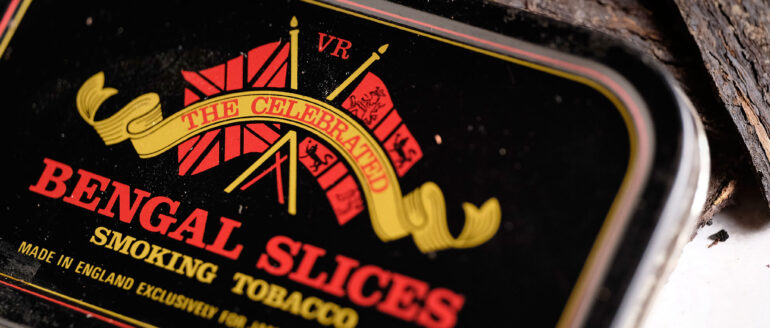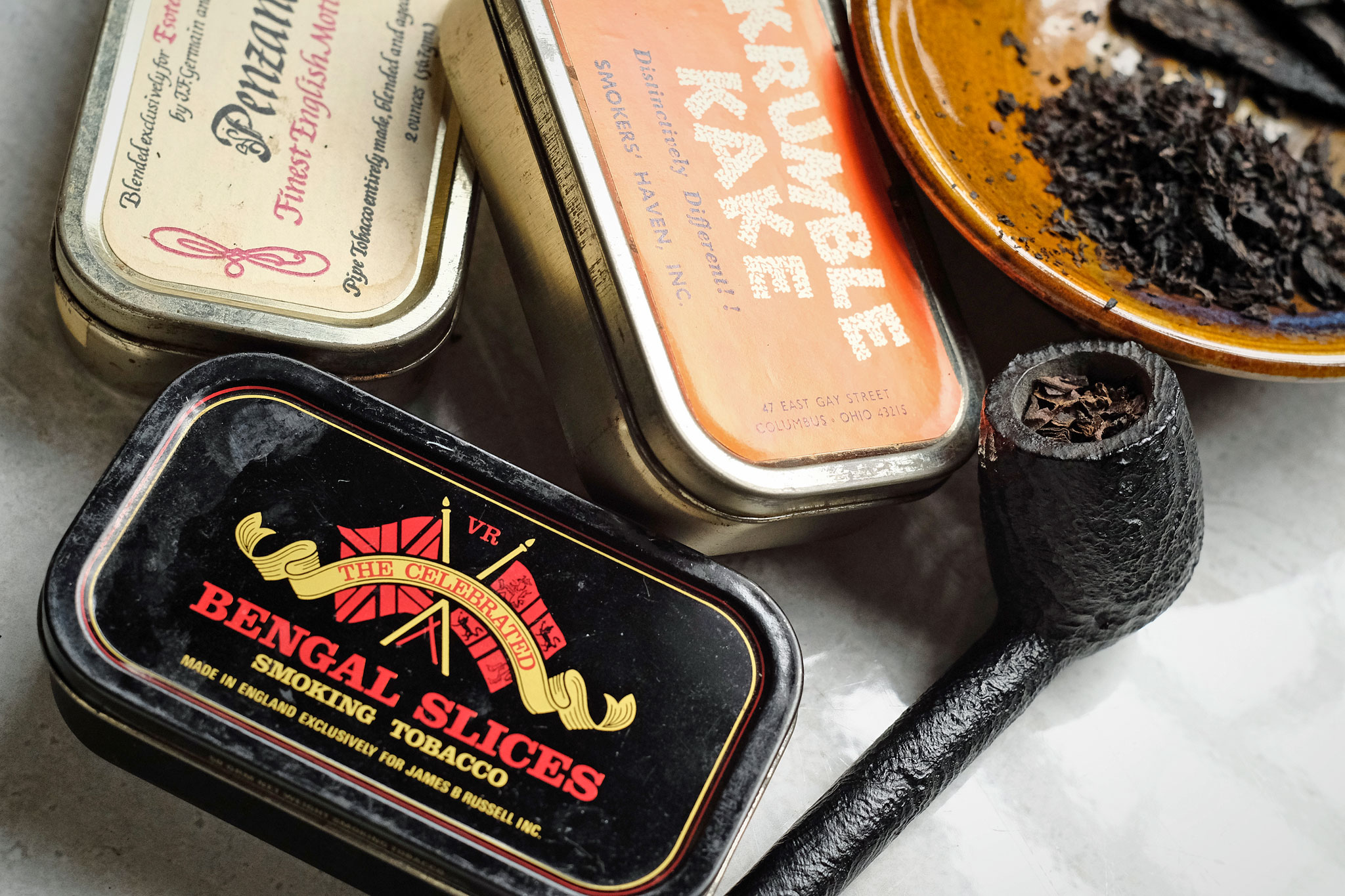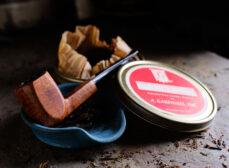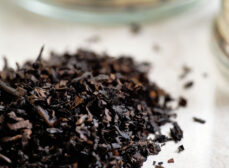
It’s far from a closely-held secret that for years I’ve had a bit of a love affair with the old, Celebrated Bengal Slices. I fondly recall my first experience with it in the late 1970s when, on one of my almost daily visits to Drucquer & Sons, a fresh shipment had just arrived. There it was, in its beautiful gloss black, red and gold livery, dramatically standing out from its peers, calling attention to itself from its perch on the shelf behind the counter.
“What’s that, in the black tin?” I asked Ken, who had become something of a tobacco mentor to me.
“The Bengal Slices? It’s great stuff,” he said, pulling a tin from the shelf and handing it to me, explaining that it was a Latakia mixture with a difference. The ribbons were pressed in blocks and sliced, so it had to be broken up to prepare it for smoking. “You have to pack it lightly, or it’ll clog the pipe and become impossible to smoke when it expands. It’s got a little bit of scent added to it.”
That last bit nearly put me off it; I was still recoiling from early experiences with heavily perfumed, goopy, pouched tobaccos that smelled better than they smoked. But curiosity, as it too often does, had its way with me, and I couldn’t resist the singular beauty of that tin. I bought it, dropped it into my satchel, and off I went.
Later that day, I popped the lid and was instantly captivated. The perfect slices, standing at attention in a tight array, dark and mysterious, almost glistening with the same hues as the tin’s lid — black, red and golden. The aroma was rich and bold, ripe with Latakia, orientals and virginias. The scent Ken had mentioned, which I’d taken as a warning, wasn’t at all overbearing, but rather soft and seductive, beautifully integrated with the tobaccos’ natural aromas. It transformed what was basically a “typical” Latakia mixture into something that seemed more luxurious, even opulent.
Though still fairly new to smoking flakes at the time, and certainly inexperienced, I had developed a bit of understanding of them. These were different, though — thicker, more robust looking. I gently removed one from the tin, placed it in my palm, and began teasing it apart. It took little encouragement for it to crumble into small fragments. As I filled my bowl, Ken’s counsel about packing forgotten (more likely arrogantly ignored), I looked forward to the first taste of my new treasure. Disaster! The charring light almost went okay, promising something good to come, but the tobacco soon went out, and stubbornly refused to light. Trying to get an ember going was the equivalent to a futile attempt to set fire to a brick of asbestos.
Frustrated, I dumped the bowl, and started again, this time heeding Ken’s advice, allowing gravity to do the work. Much better. Even at first light, it was transcendent. The richness of the tobaccos, pressed and fermented in cakes, already set it apart from its ribbon-cut peers, but that scent! Soft and diaphanous, it didn’t clash with the flavor of the tobacco, but somehow enhanced it, bringing another layer, greater dimension to what was already something pretty special, and it remained throughout the bowl, never shouting, but whispering its presence. I was immediately smitten. The next time I was in the shop, I bought three more tins, something I would continue to do periodically through the years.
At the time, I thought this was a truly unique tobacco, the only thing of its kind, but I would find out years later that it wasn’t the first, or the only, and that its story was both interesting and infused with dram of controversy. And, as it turns out, the fires of that controversy ultimately forged this tobacco into what became something so very, very special.
The Celebrated Bengal Slices was originally made by Sobranie House exclusively for James B. Russell (JBR), and first found its way to market around September of 1977. But, as early as the mid- to late-1960s, Sobranie were making a similar product for Joe Zieve’s Smoker’s Haven in Columbus, OH. Joe wanted to bring something unique to the market, something that hadn’t been done before, so he had Sobranie, who were already making the Haven’s renown Our Best Blend for him, press the ribbons, age the blend in cakes, and cut the cakes into slices. This was different from the more traditional form of flake tobacco, made from whole leaf strips, and resulted in a product Joe called Krumble Kake. It was his intention that this tobacco be compact, like a plug, yet easier than a flake to prepare for smoking. It was a hit, becoming one of the shop’s most successful blends for decades to follow.
The controversy finds us in the late 1970s, when JBR contracted Sobranie to make something similar for them. Apparently, it was a little too similar to Krumble Kake for Joe’s liking, and from what I’ve heard, his reaction was predictably cinematic, possibly going as far as threatening to discontinue his relationship with Sobranie over the apparent infraction, so JBR and Sobranie were forced to change the recipe. Whether or not the leaf formulation was changed is unknown, but the changes certainly resulted in that elusive scent joining the party. The Celebrated Bengal Slices was born. (Interestingly, JBR did not register the trademark until March, 1979, though the blend did appear in their catalogue in 1978.)
When Sobranie shuttered in 1980, licensing the production of their blends to Gallaher’s, both Bengal Slices and Krumble Kake, being proprietary products, were not transitioned to the new manufacturer. Production of Krumble Kake and the other Smoker’s Haven blends moved to G.F. Germain on Jersey, while Bengal Slices was transferred to Manchester Tobacco Company, where it was produced until 1991, then making its final move to Denmark’s A&C Peterson.
For whatever reason, the Danish product didn’t hold my affection like the UK version had; whether because of different leaf sources, changes in production methods, or the unavailability of the original secret sauce, it just wasn’t the same. In 1999, apparently because of poor sales performance, it was silently discontinued, and the trademark was allowed to expire in 2000.*
There’s one more little twist to the story. In 1988, when Stephen Richman conceived the Esoterica Tobacciana brand, he approached J.F. Germain for his blends. One of these was the now famous, and equally famously unobtainable Penzance. I was on Steve’s advisory panel at the time he was making his selections.There were two versions of a blend under consideration for Penzance. Steve chose the one with more Latakia in its composition, and while similar, it’s certainly not identical to Krumble Kake.
So, here we have a brief tale of four similar tobaccos, each with its own character, only one of which truly captured my heart. For a while, I even kept a little “emergency kit” in my car’s glove box, comprising a tin of Bengal Slices, a Perspex stemmed GBD 9438 Sablée Rhodesian, a tamper and a box of matches. You know. Just in case.
There are many tobaccos that I love, and some that I’ve loved for a long time, but there’s also something singularly special about that old Bengal Slices, and I am both blessed and cursed by having a few tins left in the cellar, tins that have been with me almost as long as I’ve been smoking a pipe; blessed, because I know it’s there, but cursed because I know that one day, it won’t be. It’s not my #1, not my all time favorite by any means, but it’s a singular blend that has a specific place in my heart and mind. Smoking it for the first time after a long absence is like remembering a first kiss. It’s a special thing, and maybe knowing that those old tins will one day be gone isn’t such a bad thing. It keeps me from devouring it, ensures that I’ll savor each tin for the memories that it holds, and for what it is, and always has been — The Celebrated Bengal Slices.
-glp

Photos by G.L. Pease
Acknowledgements: Precise dates of these things are often lost to the passage of time, but I’ve done my best to get as close as possible. Many thanks to Premal Chheda and David Zieve for filling in some of the Smoker’s Haven details, and to Jonathan Guss whose impeccable research on so many things related to tobacciana is always beyond brilliant, for helping with production and trademark dates for the various Bengal Sliceses.
*In 2015, The Standard Tobacco Company of PA acquired the trademark, and embarked to recreate a legend. To be honest, I’ve not yet tried their version of the tiger, though a tin is currently wending its way to me. When it gets here, I’ll just experience it for what it is. Comparing something modern with either the vagaries of memory or with real-life examples of something already decades old seems like folly, even to a hopeless romantic like me.



















Mad Skilz research, Greg. Thank you very much!